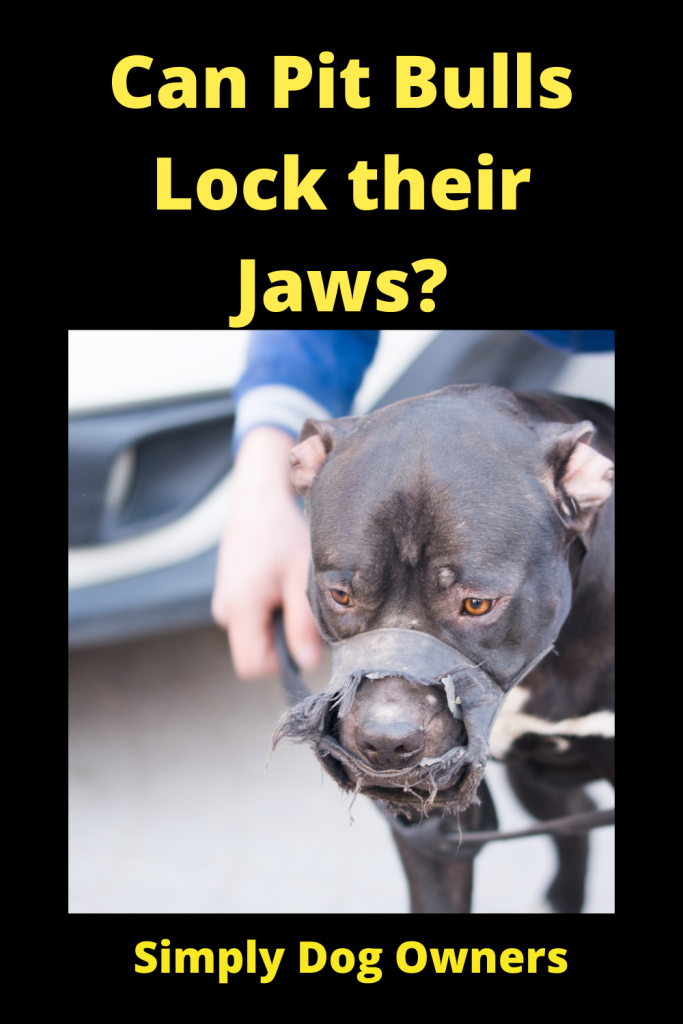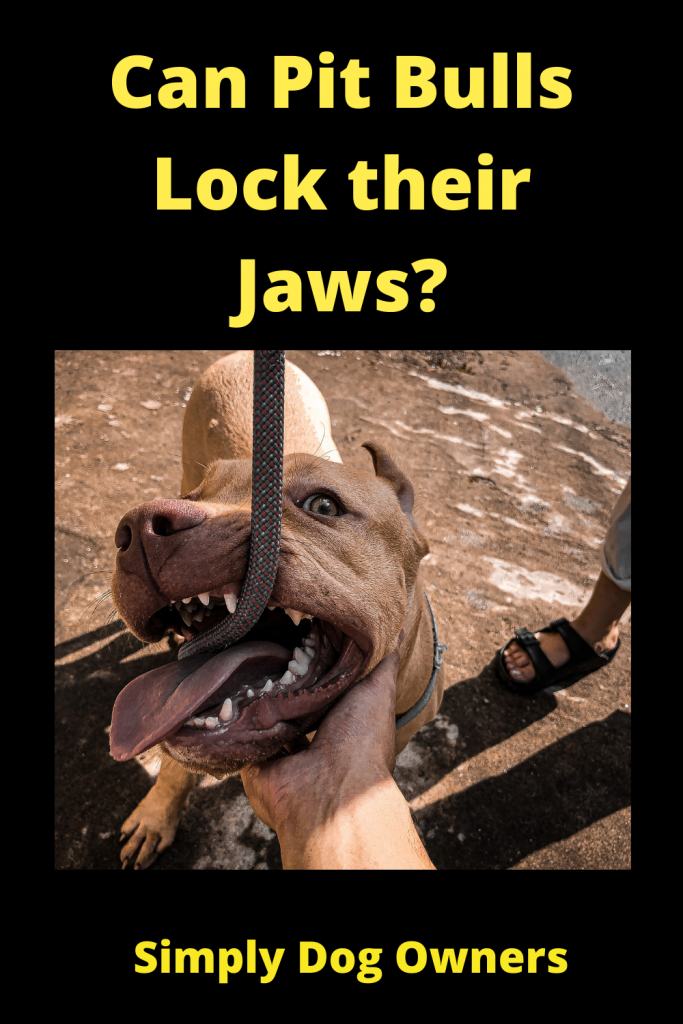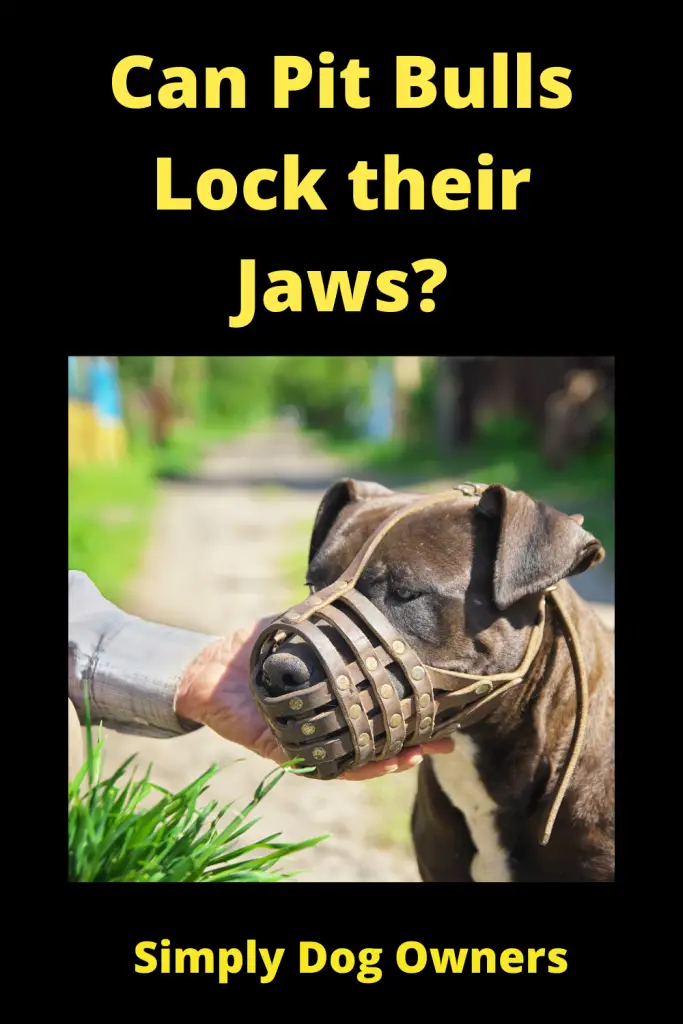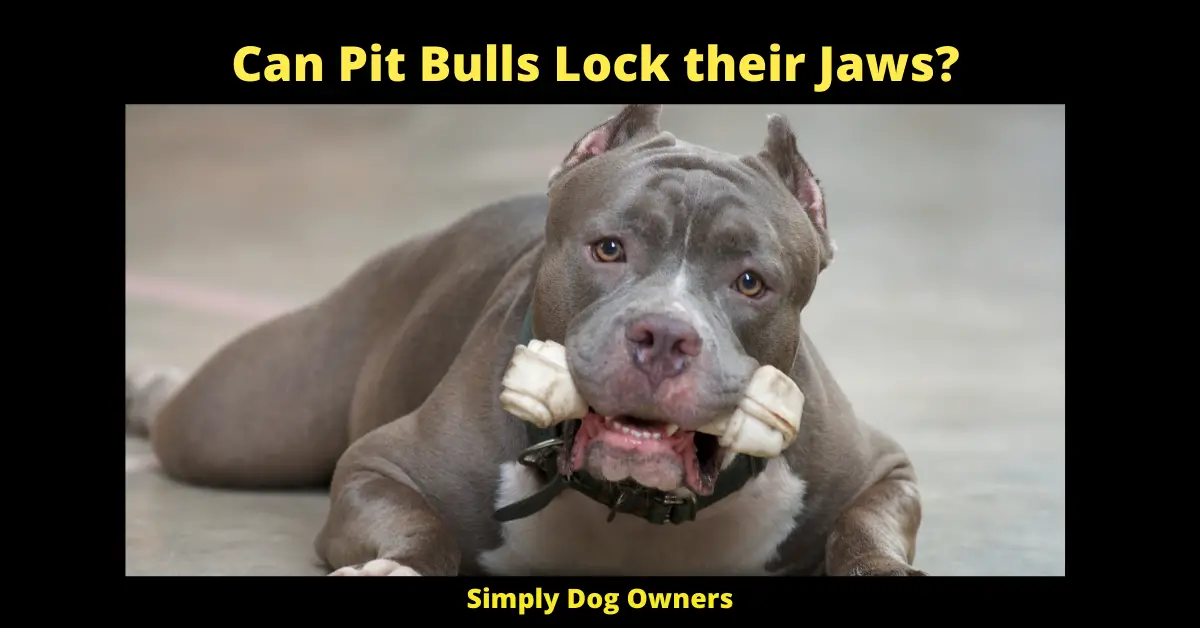As a general rule, Pit Bulls do not have locking jaws. In fact, no healthy dog does! There is an infection that can cause rigid jaw muscles and the person should receive medical attention immediately if they suspect Tetanus has set in place of their bite strength being comparable to what you would find with German Shepard’s, Bulldogs, Rottweilers or other large breeds’ bites
Can Pit Bulls Lock their Jaws?
Lockjaw in Pitbulls – We’ll discuss whether pit bulls are aggressive breeds, how to stop dogfighting, and how to safely make a pit bull release its bite and unlock its powerful jaw in this post.
Pit Bulls do not have a unique physical mechanism or enzyme that helps them “lock” their jaws. When comparing the characteristics and general bone structure of a Pit Bull skull to that of any other dog breed, you can see that they are very similar. The Pit Bull breed does, however, have one personality trait: determination. Pit Bulls are enthusiastic about everything they do, and it’s this characteristic that may make it seem as though they have a locking jaw when they bite down on something and refuse to let go.
Lockjaw in Dogs: What Triggers It?
Lockjaw in Pitbulls is a painful condition that may be crippling in some cases. The inability to open or close one’s jaw can become chronic and worsen over time. Some types of the disease can show signs of improvement, but relapse is prevalent.
Lockjaw in Pitbulls causes are:
- Temporomandibular joint ankylosis – this painful condition is caused by the joint’s immobility and consolidation, which may result in the inability to open the mouth completely.
- Luxation and dysplasia of the temporomandibular joint – pathological separation of the joint
- Trigeminal nerve paralysis – causes trouble eating and drinking due to the inability to close the mouth.
- Masticatory muscle myositis: It is an immune-mediated condition in which swollen muscles make it difficult to open the mouth.
- •Neoplasia
- Osteoarthritis
- Tetanus
- Hypoadrenocorticism, a systemic condition
- Severe ear infection
- Horner’s syndrome is a psychiatric disease.
- Retrobulbar abscess – this is an ocular disorder that affects dogs.
- A fracture of the mandibular bones
- Lesions in the central nervous system

How do you unlock a Pitbull’s jaw? Or What do I do if my dog’s jaw is locked?
Twisting the collar on a locked-on dog cuts off their air supply, causing them to release. A split stick, a short stick inserted from the side between the jaws and wedged in before the attacker lets go, is another high-risk choice for those Bedlam conditions.
Surgical procedure:
The cause determines how the condition can be overcome; the range of success is broad.
For temporomandibular ankylosis, surgical intervention in bone resection is the most common and appropriate treatment. Antitoxins and antibiotics are used in the treatment of tetanus. Masticatory muscle myositis responds well to immunosuppressive corticosteroids. However, it should be remembered that your pet can need lifelong care, albeit at the lowest dose possible, to prevent relapse.
The regeneration of the lockjaw can be accelerated by treating an underlying condition such as severe ear disease. Treatment for a systemic disease like hypoadrenocorticism will also help with rehabilitation but bear in mind that a systemic illness will require ongoing medication and supervision.
In general, the prognosis for lockjaw is favourable; but, if muscle atrophy is severe (due to complications such as fibrous muscle), the outlook could be bleak, and your pet may have difficulty eating and drinking. Furthermore, causes such as a tumour or a severe trauma may result in a less favourable outcome.
What Dog has the most Muscular Lockjaw?
There is yet to be discovered. Several dog breeds have been blamed for the notorious “locking jaw” myth, including the American Staffordshire Terrier, Bulldog among Boxer, Pitbull, and others.
But these are the top 8 Dog Breeds with the Strongest Jaws
- Kangal
- Bandog.
- Wolf/Dog Hybrid
- Rottweiler
- American Bulldog
- German Shepherd
- American Pit Bull.
- Chow Chow.
Do Pit Bulls Suddenly Snap?
Yes, if they aren’t adequately trained, they will snap. When your dog unexpectedly snaps, it can be a terrifying experience. It’s much more frightening when the dog is a pit bull responsible for over 65 percent of all dog bites and fatalities in the United States.
A snap is usually a warning sign that something is becoming too much for your dog to bear, and it should never be ignored.
Snapping, biting, and other violent activities are among the most common reasons for dogs being surrendered to shelters. But don’t include the pit bull in these numbers if he snaps. Try to figure out why he snaps and what you can do to stop him from acting aggressively.
Why Pit Bulls Snap?
There are several urban legends of pit bulls snapping or attacking without warning. The fact is that any dog (not just pit bulls) will snap at any time, and there is a reason for it. A dog that is happy and safe is unlikely to snap or strike.
Knowing why the pit bull is snapping or behaving aggressively is crucial to devising the best plan for getting him to quit this obnoxious behaviour.
Pit bulls snap for a variety of reasons:
1. In Response to Pain
If your pitbull is hurt or in pain, he will lash out at you if you attempt to touch him, believing that you are the source of the discomfort. When someone reaches for an injured part of your body, you would instinctively drive them away even though they are a human. When your pit bull has been damaged, he will exhibit a similar type of reflex.

2. Ailment
Aside from injuries, disorders like brain tumours and cognitive dysfunction can damage your dog’s brain, causing him to act aggressively and snap at inappropriate times. Although these problems are more common in older pit bulls, they can occur at any age.
3. Anxiety
If a pit bull senses that he is in danger and wants to protect himself, he is likely to snap. Your pitbull is expected to snap if he is trapped in a confined space or believes a raised hand over his head is aimed at him.
4. Possessiveness
Your pitbull can even snap to protect a valuable resource such as toys, food, or other valuables. If your pitbull is possessive, he can snap if you approach his food or get too close to him when he is chewing a bone.
5. Disappointment
Pit bulls, like other dogs, can snap if they aren’t given what they want when they want it at a specific time. Pit bulls who are restrained on leashes or that spend a lot of time tied up are vulnerable to this form of violence.
If your dog starts barking at all around him the moment you put a leash on him, realize that the leash is causing him frustration. This is also known as leash resistance, and it occurs when a dog feels restrained or irritated by his or her leash.
6. Nervousness
Recent changes in your pit bull’s environment may have made them nervous, causing violent actions such as snapping. Moving to a new home or welcoming a new family member are two common causes of anxiety.
7. Demonstration of Dominance
Pit bulls, like other dogs, can snap or act aggressively as a show of dominance. It’s typically aimed at other dogs, but it may also be directed at you or other people. There will be times when your pitbull believes he is in command of a situation. When he thinks that his status is being threatened, he snaps or growls—attempting to pick him or walking through a door simultaneously as he is both examples of challenging his position.
8. Maternal instincts
A pit bull mother can also snap if you approach her puppies. This is because her maternal instincts outweigh her love for you. Please consult your veterinarian or consider having her spayed, as this form of behaviour will last even after the litter is gone.
What to Do If The Pit Bull Becomes Abusive
After you’ve figured out why your pitbull snaps, you’ll need to deal with the issue; here’s a short rundown of your options:
- Avoid Potential Triggers: When your pit bull paws at you, the first thing you can do is keep him away from anything you think is triggering the unexpected outburst of aggression. Avoid touching him if he doesn’t like it, and allow him some space to calm down. You have to use strong baby gates or a cage to hold him comfortably contained before you see your visitors off if he’s barking at them.
- Try Desensitization Exercises: If you think your pitbull is snapping due to territorial issues, try getting in new people regularly. You should gradually increase the number of people you bring over as he responds to new stimuli and avoids snapping.
- Provide a Calm Environment for Him: Try to stick to a consistent schedule so that your pitbull knows what to expect during the day. It’s also crucial to maintain your composure. Your dog can sense when you’re stressed, and your stress may be rubbing off on him in the wrong way, causing him to become aggressive. To help him feel more at ease, consider placing a few chew toys or purchasing a relaxing bed.
- Supplements: To help him stay calm, try giving him regularly soothing supplements. Sedatives should be avoided because they can aggravate the situation and put the dog at risk of seizures or low blood pressure. Give him nutritious treats and take him for a walk after calming down after taking the supplements to keep him safe.
- Consult a Veterinarian: A veterinarian may assist you in determining what is triggering the violent conduct. A veterinarian will examine your dog if it has been injured or is suffering from a medical condition to assess the injury’s root cause and sudden aggression.
- Hire A Professional Dog Trainer: After a veterinarian and all medical issues have treated, your dog has been ruled out, you can hire a professional dog trainer, preferably one that specializes in dog abuse assist you in correcting the violent conduct.
As you can see, there are a variety of reasons why your pitbull or another dog could snap. Snapping activity is not unusual in dogs, so don’t be worried. While it can be frightening, especially if your dog has always been quiet and relaxed, it is more of a behavioural problem that can be resolved with proper training and socialization.
Depending on the nature of your pit bull’s snapping behaviour, a minor adjustment in his environment, daily routine, removing stressors, or working with a vet or trained dog trainer might be necessary. Whatever steps you want to fix your child’s snapping actions, keep in mind that it is a worthwhile endeavour.
How to Get a Pit Bull to Release its Bite
The trick is to stay ahead of the game! Most biting cases can be avoided by having a well-trained dog. If you choose to adopt a pit bull, begin obedience and other forms of training as soon as possible, and socialize your dog with various people and animals.
Things do, after all, happen. There are a few techniques for getting a pit bull or any other dog to release a stubborn bite. Both of these put you at risk, which is why we recommend that you train your dog.
If a hose is open, one technique is to squirt the dog with it to distract it. This type of shock can divert the dog’s attention away from its perceived prey, allowing you to gain control. Wedging a breaking stick into the pitbull’s mouth is another choice. This necessitates placing the hand and arm near the mouth of the attacking dog. And if it’s your puppy, there’s a risk of injury.
Grasping a dog’s tail can always cause it to come to a halt. If you follow this approach, you must continue to keep the dog’s tail so that it does not turn around and bite you. You can also catch a dog’s back legs and quickly turn it onto its back, but this puts you in danger.

What is the definition of a Good Boy (Pitbull)?
Both dogs can be taught to release the unusual bite with proper training and socialization. Pitbulls have a bite force that is about half that of other breeds. Their bite is dangerous because of their propensity to cling and shake.
Any canine breed is capable of biting and refusing to release, so no matter what species you have, it’s critical to begin training them from the time they’re puppies to shake toys and release when you say so. When dealing with potentially risky habits, always consult your veterinarian or a trainer.
Are Pit Bulls Naturally Aggressive?
Aggression toward humans is very unusual in pit bulls. They aren’t instinctively or necessarily hostile to people. Aggression is influenced by various factors, including the environment, growth during crucial times, and, most significantly, human nature.
While they’ve been bred to attack other dogs or bulls for years, they’ve never been bred to attack humans – a trait that’s very different from animal aggression in dogs. Furthermore, breeding any two dogs (pit bull terriers or otherwise) that display signs of actual animal or human violence is now frowned upon in the responsible breeding culture.
Are Pit Bulls Dangerous?
Some pit bulls were chosen and trained specifically for their fighting prowess. As a result, they may be more likely to compete with other dogs than other breeds. It doesn’t mean they can’t be around other dogs or that they’re violent in unpredictable ways. Other pit bulls were bred to provide work and companionship.
These dogs have long been common household pets due to their gentleness, affection, and loyalty. Also, pit bulls that were trained to combat other animals were not violent against humans.
Dogs used for combat had to be treated daily by humans, so violence against humans was not accepted. To prevent passing on such an undesirable characteristic, any dog that acted violently against a human was culled or killed.
According to research on pet dogs, aggressive dog dogs are no more likely to direct hostility against humans than dogs that aren’t aggressive to other dogs.
The vast majority of pit bull style dogs in our communities today are almost certainly the product of random breeding—two dogs being mated without concern for the behavioural characteristics that would be passed on to their offspring. Accidental breeding produces a population of dogs with a wide variety of behavioural tendencies. As a result, it’s critical to assess and handle each dog as an individual, regardless of breed.
Are Having Pit Bulls Illegal in any States?
Since the list of states that enact BSL is long, we’ll start with those that ban BSL or breed discrimination. California, Colorado, Texas, Illinois, and Florida are the states in question. Alaska, New Hampshire, New York, Arizona, Connecticut, Maine, Massachusetts, Minnesota, Hawaii, Nevada, New Jersey, Oklahoma, Pennsylvania, Rhode Island, South Dakota, Utah, and Virginia are the states that do not enforce or ban BSL. Some of these states, including Utah, have made it illegal for municipal councils to create their BSL, shielding dog owners and pets from arbitrary and contradictory rules based solely on speculation.
States that are Unfriendly to Pit Bulls
Breed-specific legislation has been enacted in the other states, or BSL bans have been repealed. And if the conditions haven’t passed legislation, local governments can enact legislation prohibiting importing such breeds within their boundaries.
Check with the city you want to relocate to see if you and your pit bull are welcome in the BSL states. You will be able to relocate to a BSL state to escape the unwelcome municipalities with pit bull bans. Wisconsin, Iowa, Kansas, Arkansas, Ohio, Missouri, Mississippi, Louisiana, Michigan, and Kentucky are the ten states where you and your pit bull dog are most likely to get the cold shoulder. The state with the most BSL is Iowa, which has over 90 municipalities. BSL is in effect in just over 30 Kentucky municipalities.
Do Pit Bulls Turn on their Owners?
Attacks on a dog’s owner by a Pit Bull are sporadic. However, if you do not have proper training and nutrition, they will become aggressive. Also, a violent encounter with a pit bull may result in significant bodily harm.
What were Pit Bulls Bred For?
Initially, they were bred to bite and hold bulls, pigs, and bears. The modern pit bull is descended from the original English bull-baiting dog, which was trained to bite and hold bulls, tigers, and other large animals in the face and head. When it became illegal to bait large animals in the 1800s, people resorted to fighting their dogs against each other.
Can a Pit Bull Kill You?
Pit Bulls are capable of causing considerable harm due to their robust bodies and tough jaws. They are responsible for a disproportionate amount of severe dog bites resulting in extended hospitalizations and even death.

What Triggers a Pit Bull to attack?
There is only one explanation for this: a mutation that triggers a brain defect that manifests as violent behaviour and an inability to regulate it. It has nothing to do with how you parent them or what you do or don’t do; it’s all about their genes.
Final Thoughts – Can Pit Bulls Lock their Jaws?
Pitbull jaws do not lock when they bite, contrary to popular belief. They are a breed known for their stubbornness, which shows in everything they do. No dog breed has a mechanism in its mouth that allows it to lock its jaws.
Pitbulls and other bulldogs were developed for bull-baiting. Bulls were pitted against other species in this now-outlawed bloodsport. Bulls are vast and powerful animals. Bulldogs were bred to be able to hold on as they buck violently.
Many people kept Pitbulls and other bulldogs after bull-baiting was outlawed or crossed them to preserve some of their characteristics. These dogs are solid and capable of navigating a variety of challenging terrain. They are intelligent and persistent, making them excellent working dogs.
The pitbull is adamant about finishing everything, including biting. As a result, having a pit bull to stop can be incredibly difficult. From puppyhood on, it’s critical to teach all dogs, regardless of breed, to follow your order to “stop” or “leave it.” Any dog that bites will be hesitant to be released.

